|
FAQs about "Freshwater" Morays Eels
4
Related FAQs:
FW Morays 1,
FW Morays 2,
FW Morays 3, FW Morays 5,
FW Morays 6,
FW Moray ID,
FW Moray Behavior,
FW Moray Compatibility,
FW Moray Selection,
FW Moray Systems,
FW Moray Feeding,
FW Moray Disease,
FW Moray Reproduction,
Marine Moray
Eels,
Related Articles:
Freshwater Moray Eels by Marco Lichtenberger,
Freshwater Moray Eels by Bob Fenner,
Moray Eels, Other Marine Eels,
|
|
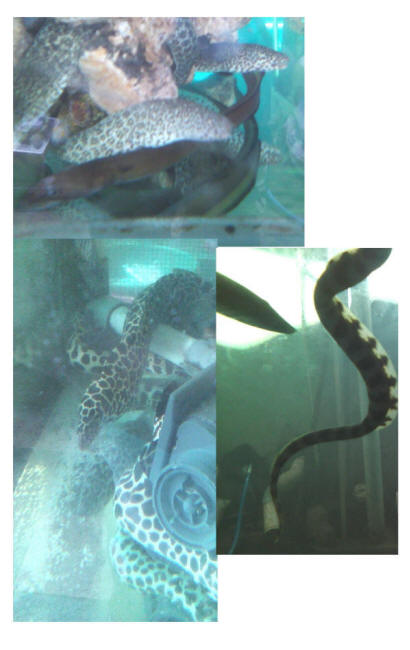 |
|
My initial hydrometer readings 12/26/17
Hello Neale,
<Marco here again. Got your email in my inbox.>
This is my initial hydrometer readings. The seawater which I took from the beach
of Jakarta, is about 1.020-1.021. My well water is 1.003-1.004, and my aquarium
is 1.008 sg. so, this means my aquarium is low-end brackish, am
I right?
<I'd call it mid brackish with about 1/3 SG of average seawater, but you also
call it high low-end brackish. >
Best Regards, Ben
<Cheers, Marco.>
|
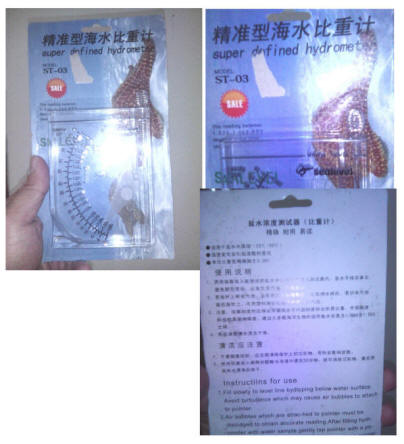 |
Re: My initial hydrometer readings & a new G.
Polyuranodon! 12/27/17
Hello Marco, Neale & all you good people in WetWebMedia,
<Hi Ben.>
Thank you for replying & informing me how to use the hydrometer in the
earlier e-mail. Glad to know that my hydrometer works. I guess now I
officially joined the cult of the brackish water aquarist! :D
<Yes, you have.>
I will keep you informed about my latest (amateur) research into morays. As
I mentioned in an earlier (separate) e-mail, I just obtained a G.
polyuranodon (finally!) so, more eels to watch and observe. It's a cute
fish, just as cute as my Echidna rhodochilus.
<Nice eel. Is among my favourite moray eel species. They are hardy and not
very aggressive (for a Gymnothorax). Although they reach a length of around
3 feet with time, they remain quite thin and have a much smaller body mass
compared to other eels of that length.>
Best Regards, Ben
<Cheers, Marco.>
Re: Various types of Morays that are usually caught in the rivers in
Indonesia 12/27/17
Hello Marco, Warm Greetings from Indonesia, Merry Christmas to you too!
<Thanks, Ben. Hope you had a good time.>
Thank you for clearing up that "honeycomb moray" and "Tesselated moray"
refer to the same species: Gymnothorax favagineus. This species are very
common in our aquarium trade. And thank you for informing about Gymnothorax
isingteena's Latin name. It's also rather common here.
I will keep you and Neale updated with the results of my latest findings. I
just acquired a G. polyuranodon (Christmas present, Yay! :D ), so now I have
one more eel that could be observed in my aquarium :D
<Very good. Looking forward to hear about your observations.>
Best Regards, Ben
<Cheers, Marco.>
|
Re: My initial hydrometer readings & a new G. Polyuranodon!
12/28/17
Hello Marco, Neale and all you wonderful people at WetWebMedia,
<Hello Ben.>
What species of morays (other than the G. polyuranodon and E. rhodochilus that I
already have) that would thrive in my aquarium at 1.008 sg brackish water?
<Gymnothorax tile should work, but in my experience is healthier at higher
salinities. Strophidon sathete probably would do well with regard to salinity,
but gets too large for usual aquariums. I am not aware of any other morays able
to permanently live in mid brackish water.>
Thank you & Best Regards, Ben
<Cheers, Marco.>
|
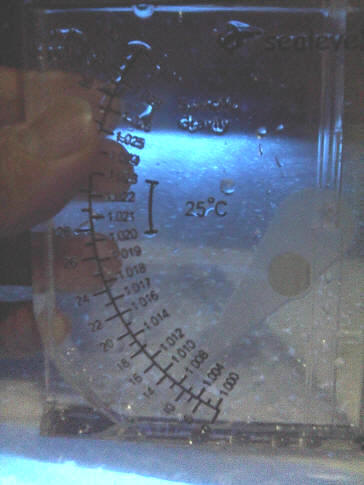 |
|
Echidna rhodochilus, finally. Feeding
10/28/17
Hello Bob, Neale, Marco and all you good people in WetWebMedia, After years of
searching, I finally obtained a small Echidna rhodochilus (35cm), and I'd like
to share its pictures with you. It's a lovely eel, but very amusing, just
minutes after being released in my aquarium, it already terrorized my shrimps
and ate two of them.
The previous owner hand-caught this eel from a river mouth called Muara Tawar in
North Bekasi, a neighboring city of Jakarta. He already kept this eel in his
aquarium for about a year, in the same water from the river where he caught it,
and haven't weaned it off live food yet. This particular Echidna won't eat dead
shrimp. Since I have steady access to live shrimps, I don't mind this. But I
heard that eels love a variety of different foods, so, If I put Sailfin mollies
in the aquarium, will they causes harm to the Echidna if it eats them?
Thank you and have a nice weekend!
Best Regards,
Ben
<Hello Ben. Congratulations on getting hold of this fish! Nope, Poecilia species
are harmless, at least in terms of thiaminase. They are, of course, the same
risk as any other farmed fish in terms of internal parasites and pathogens.
Home-bred specimens should be safer, so if you have the space and inclination,
producing your own livebearer or killifish feeders is relatively safe (though
Poeciliids seem to be plagued with Camallanus worms that could transfer from
mother to offspring, so even here, I'd be careful). Gut-loaded shrimps are a
safer and more natural foodstuff for Echidna species that have, on the whole,
crushing dentition for invertebrate prey compared to the pointed teeth of the
piscivorous morays from other genera. Gut-loading is important though because
crustaceans tend to be high in thiaminase, hence shrimp and prawn meat being
considered an unsafe staple diet for these (and other) carnivores. I will also
remind you that 'freshwater' morays lose their appetite when the salinity is too
low, so kicking up the salinity may be helpful. Bob and Marco have written
extensively on this/these fish; see here:
http://www.wetwebmedia.com/FWSubWebIndex/fwmorayeels.htm
http://www.wetwebmedia.com/FWSubWebIndex/fwmorayart.htm
Cheers, Neale.>
|
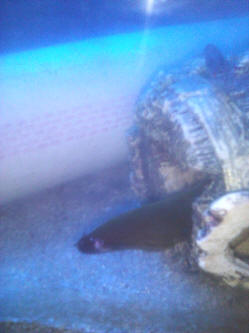
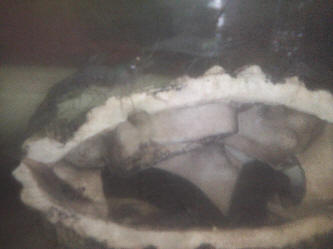 |
|
Re: Echidna rhodochilus, finally
10/28/17
Hello Neal!
<Ben,>
Thank you for the kind words & advice. That was fast!
<Thanks for the kind words.>
Again many thanks. I think I don't have the inclination to breed the mollies
myself, so I'll have to stick with fortified shrimps for now.
Anyway, there are still some shrimps left in the eel tank, and seems like
they'll all be consumed within a few days, so, after they're all gone, how
many days should I wait until I put on some more live shrimp?
<I would not overfeed; with subadult to adult predatory fish, the aim is to
offer food only when they're actively hunting. Personally, I prefer the "little
but often" approach with predators, offering them small daily meals
rather than infrequent big meals, simply because it limits the risk of
regurgitation or uneaten food being left in the tank. Other people prefer a more
'natural' approach where the fish receives a substantial meal, but maybe 2-3
times a week, but taking care to remove any regurgitated or leftover food before
water quality was compromised. But whatever approach you take, a couple notes
about Morays. First, they hunt by smell. Adding too many food items at once
means the 'smell' gets spread around the tank, and the Moray can have trouble
finding it. So get some long forceps or something like a kebob or satay skewer,
use this to hold a single food item, and place the item somewhere just upstream
of the Moray. Wiggling the food enticingly can help, especially if the food is
silvery, like a small piece of fish. If the Moray is settled and hungry, it will
start hunting.
The second time is to keep the food bite-sized. Morays can't chew, and despite
their ferocious reputation, they actually favour small, easily swallowed food
items. Once the food item is taken, repeat a few minutes later. If the Moray
shows no interest, it's probably had enough, and you can skip feeding until
tomorrow or the next day.>
This particular Echidna Rhodochilus is already 30 cm in length so I assume it is
an adult, which shouldn't be overfeed, right?
<Quite so.>
And thank you also for the advice for raising salinity when necessary. I'll try
to find a hydrometer so I know exactly what is the salinity rate of my eel tank
& adjust accordingly. I have access to seawater (the blessed life of people who
lives in coastal cities & not far from estuaries :D ) so it's not inconvenient
to mix some seawater to the eel tank.
<Indeed! Sounds nice, especially if you can vary the salinity periodically, up
or down, as you see fit. Brackish water fish appreciate this, even though they
don't need it. Often you'll see them perk up their behaviour almost as if
they're exploring a new tank.>
Best Regards,
Ben
<And to you. Cheers, Neale.>
Re: Echidna rhodochilus, finally 10/28/17
Hello Neale,
Again, many thanks for the feeding info & salinity tips!
<Welcome.>
Speaking of feeding, the remaining shrimps are rather large, and when I turn
down the lights, they gather above the Echidna's cave. I wonder what's going on?
Are they teasing the eel?
<Nope. More than likely scavenging, and if the Moray withdraws to his cave to
eat his food, there could be all sorts of small food fragments thereabouts
attracting them.>
As in "hah, we're too big for you, you cant eat us, heh heh!"? Should I evict
them later?
<Unless they recognise the Moray as a threat, there's no reason for prey animals
to keep away.>
Best Regards,
Ben
<Those are quite big shrimps, for sure! But gut-loading with traditional fish
flake, Spirulina and, if you can get it, Sushi Nori algae sheets, will all help
to boost their vitamin content and turn them into useful food items. There are
marine-grade vitamin supplements, such as Selcon, that can be used -- sparingly
-- to good effect as well. With freshwater and marine carnivores, a lot of
failure over the long term -- months, years after purchase -- may be explained
by lack of vitamins, including Thiamine.
Longer term of course, getting your Moray onto a fresh and frozen diet will be
helpful. Cheers, Neale.>
Re: Echidna rhodochilus, finally
10/29/17
Good day Neale!
<Ben,>
Thank you for the tips for fortifying the feeder shrimps. I can give them both
fish flakes (available here) and the nori seaweed (I think I saw them on a mall
somewhere). The Echidna is so cute, it is worth all the efforts to give it a
good home.
<Quite so. A nice fish, and like all Morays, amply rewards good care.>
Speaking of home, I just find this video on YouTube, of a Gymnothorax Tile
sharing an aquarium with a Polypterus, both seemed to be at peace with each
other, and both still retain their huge appetite for food (though their owner
seems to be able to wean the G. Tile away from live food & able to give it
frozen shrimp...)
https://www.youtube.com/watch?v=bFXue8NHFRs
Is this some kind of black magic, or is there some kind of chemical stuffs
involved?
<No, just luck and time. Gymnothorax tile WILL NOT live its full lifespan in
freshwater, and that specimens just a baby.>
G. Tiles are supposed to be brackish water to marine species, while Polypterus
are totally freshwater species.
<Yes and yes.>
How could they share the same aquarium like this, without affecting their
appetite and behavior?
<The "freshwater" Morays certainly do live some months in freshwater, and
youngsters maybe even a year or more. But eventually, without fail, they stop
eating. Aquarists who fail to give them brackish water usually end up with a
starved, then dead, Moray.>
If this is a brackish water setup, maybe the Polypterus has some tolerance to
higher salinity?
<Unlikely. While the Ropefish, Erpetoichthys calabaricus, has some tolerance for
slightly brackish conditions, I'm not aware of any true Bichirs in even slightly
brackish habitats.>
If yes, maybe I'll introduce a Polypterus or two to keep my Echidna accompanied.
What do you think?
<Bad idea. Morays make poor companions. The fact they hunt by smell means they
sometimes bite their tankmates! I'd tend to keep yours either singly, or in due
course, with some large, robust brackish or marine companions --
big sleeper gobies, brackish water lionfish, toadfish, that sort of thing, maybe
even Scats and Monos if you had enough swimming space for them. In low-end
marine tanks, pretty much anything will work, including robust
Damsels and Sergeant Majors. Any of these would make more realistic companions.>
Best Regards,
Ben
<Welcome. Neale.>
|
Re: Echidna rhodochilus, finally 10/30/17
Hello Neale,
<Ben,>
Thank you for confirming my thoughts. Everything I read about G. Tile online
pointed out that this particular fish is more brackish to marine than
freshwater.
<Quite possibly migratory; Fishbase suggests an anadromous life cycle, living in
the sea or estuaries, but spawning in the freshwater parts of rivers. In any
event, the experience of those keeping this species suggests brackish will work
fine long term, but freshwater doesn't.>
So, I understand that combination of Polypterus and G. Tile is "suicidal", if
it's too brackish, the Polypterus would eventually suffer, if it's too fresh,
the G. Tile will suffer. Not good!
<Indeed. Suicidal would suggest either of the fish are choosing to die in the
wrong conditions -- not the case here!>
As for my Echidna, for now I will let it enjoy the tank by itself and its prey
shrimps. This little guy really has personality, I noticed that if the lights
are bright, it will behave like a dragon on its lair, sitting nicely on its
cave. But when the lights are dimmed, after awhile it will start to "patrol" its
surroundings & terrorizing the shrimps. Fascinating isn't it?
<Absolutely, and precisely how they behave in the wild. During the daytime
Morays are inactive but not asleep, and will indeed lurk with their heads poking
out, showing an interest in what's happening in their part of the world. At
night they become active, and that's when they hunt.>
I will eventually get a friend for the Echidna. Sleeper goby sounds cool, and
it's a fierce-looking fish, just like the Echidna, so they will make a great
conversation piece.
<There are some excellent large Sleepers out there, but do bear in mind such
tankmates need to be at least as big as the Moray, otherwise biting is a risk;
even if the Moray doesn't actually kill the target, its bites can quickly become
infected.>
I am thinking to get myself a G. Polyuranodon, but I wonder, will they get along
together?
<Morays can get along in very large systems with plenty of caves, but they can
be unpredictable, so I would tend to keep them singly. Do read here:
http://www.wetwebmedia.com/fwsubwebindex/fwmorayart.htm
There's a section on tankmates.>
Have a wonderful day!
Ben
<It's almost bedtime here, so will save that for tomorrow! Cheers, Neale.>
|
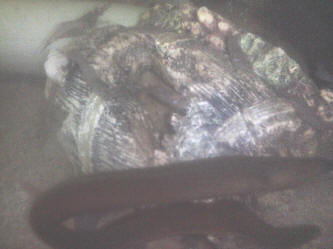 |
Re: Echidna rhodochilus, finally 10/31/17
Hello Neale,
<Ben,>
Thank you for the interesting info about G. Tile behavior. Of all three species
that is labeled "Freshwater Moray", perhaps G. Tile is the least deserving of
the title. G. Polyuranodon perhaps is the most deserving, but even so, I think
G. Polyuranodon and E. Rhodochilus will do better in slightly brackish water, as
it's their natural habitat.
<Indeed. But I'm not sure any true eel (Anguilliformes) is 100% freshwater --
even the true freshwater eels, Anguilla spp., return to the sea to breed. My
assumption would be that freshwater morays will have a marine
stage to their life cycle, at the very least, and even Gymnothorax polyuranodon
is rarely found more than a few km inland, indicating that even though adults do
seem to be primarily freshwater to low-end brackish, they do need to be able to
get to the sea to breed properly (whether directly or via planktonic larvae I do
not know, and don't think anyone else does either). Do see, for example, here:
https://www.ncbi.nlm.nih.gov/pubmed/21722111
Plus the various Fishbase articles on freshwater morays.>
Today I went to the seashore to collect some seawater (about two bottles of 600
milliliters), will mix some of it to my Echidna Rhodochilus aquarium sometime
later, to change the salinity, and let's see how the Echidna behaves afterwards.
<Cool.>
I am still unable to find any local fish store which even know what a Hydrometer
is, and I am too poor (for now) to buy it online from abroad, but I'll keep
searching.
<For brackish, they're not essential. If you mix, say, one bucket of seawater
with three buckets of freshwater, you'll have around 25% normal seawater, i.e.,
SG 1.005 at 25 C. That's fine for most brackish water fish.
Provided each water change is done with something along these lines, one part
seawater to three parts freshwater, any slight discrepancy in specific gravity
(or salinity) won't be enough to cause harm to your fish or filter.>
Thank you and have a nice day!
Ben
<Welcome! Neale.>
|
Re: Echidna rhodochilus, finally
11/1/17
Good day Neale,
<Hi Ben!>
Yesterday I have mixed approx 1000 ml of seawater, taken from the beach of
Jakarta, to the Echidna aquarium. I also decided to take out the ugly white pipe
and replace it with two shorter, darker pipes, which matches my
aquarium better. Echidna seems to like it better, as he seem to enjoy chasing
shrimps round and round the two pipes.
<No doubt. PVC pipes are fine, but they do reflect light unnaturally. Can work
nicely once covered with a bit of algae though, or if buried in coral rubble.>
After the seawater addition, Echidna still behaves more or less before, except
for a few changes. I notice that it is now "calmer", not darting around quickly
during its "patrols" as often as before. And it seems to leave its cave more
often, in favor of the two new pipes. My friend, the one who own a Polyuranodon
that I've been trying to buy for years (unsuccessfully), noted that Polyuranodon
also behaves more or less the same, if it has more than one hiding places, it
will use all of them, not just stuck to one place. Have you observed this with
other morays you have seen/kept?
<Yes; Morays are definitely territorial, but they are also curious, and in their
way, intelligent. Anyone who has kept Freshwater Eels (Anguilla spp.) will have
noticed the same thing. These are 'cunning' animals that learn their territories
well, and expect to have a 'get-away' burrow or two that they can use if chased
or otherwise molested.>
Anyway, according to Google, my home in Pulomas Jakarta is only 12 km from the
sea. The North Bekasi area where my Echidna were caught, has more or less the
same distance from the sea, so maybe our rivers here in Pulomas and North Bekasi
are not pure freshwater, but perhaps have some brackish water mixed in.
<Possibly, but it may well be that it's plain vanilla freshwater, and the
proximity to the sea is more about reproduction, as we've discussed before.
Or it could be these fish are casually migratory. By that I mean they simply
swim up or down river as the mood takes them, perhaps several times a year.
Adult Scats, for example, certainly do this, and can be found 50 km
inland, even though they are more common in the sea or estuaries. The truth is
that we don't really know very much about how brackish water fish live.
They are not well studied by scientists, and fishkeepers are not as experienced
with them as reef fish or rainforest fish. People keeping freshwater Morays are
doing groundbreaking stuff here, and it's useful to keep notes and discuss with
other fishkeepers.>
I'd love to check their salinity once I get my hands on a proper Hydrometer.
<And I'd love to hear what you learn!>
If it's true, that explains how my friend is able to keep Polyuranodon for years
simply by using the water from the river, no marine salt required.
<Quite so.>
Thank you for pointing me to Fishbase and the scientific paper. I also find your
interesting comment in this forum:
http://www.fishforums.net/threads/identify-my-brackish-moray-eel.105762/
<Oh! That's going back a while.>
You said: "...Gymnothorax polyuranodon for example is said to be a catadromous
species, that is, while adults may inhabit brackish or fresh waters for extended
periods, they return to the sea to breed. This agrees with Schafer's records of
these fish being found 'a long way upstream in completely fresh
water'....Gymnothorax tile on the other hand is *suggested* to be anadromous,
meaning that it inhabits brackish and marine waters as an adult but breeds in
brackish or fresh water....Echidna rhodochilus isn't referred to as either, so
by implication may be euryhaline, swimming and breeding wherever it wants..."
<Hmm...>
I found it so fascinating. So, there are not much scientific info about Echidna
Rhodochilus?
<Not really, no. If you Google 'Echidna rhodochilus' you will get some links,
including a first report of the species from mangroves of the
Andaman & Nicobar Islands, which is cool. I do suspect they're simply plain
vanilla euryhaline brackish water Morays, rather than true freshwater species,
as might be the case for (adult) Gymnothorax polyuranodon.>
That's too bad. I hope my observations here on my own aquarium will help to shed
some lights on this fascinating fish.
<As do I.>
I also hope that someday people would find a way to breed Echidna Rhodochilus. I
think it's the ideal pet moray. It stays small, not so aggressive, it's
freshwater to brackish, it's very cute and it has long live if taken care
properly.
<It does seem to be a very good aquarium fish, given the right conditions.
Some of the smaller marine Morays have a well-earned place as rock-solid
aquarium residents, and with a bit of care, Echidna rhodochilus would seem to be
much the same sort of fish. Healthy specimens are really gorgeous,
with a lovely velvety sheen, and as you say, they're relatively mellow -- though
I wouldn't trust them with small or delicate tankmates.>
Well, have a nice day and thank you again for your wonderful discussions, you're
very kind & a true expert of this field!
<Thanks for the kind words.>
Best Regards,
Ben
<Cheers, Neale.>
|
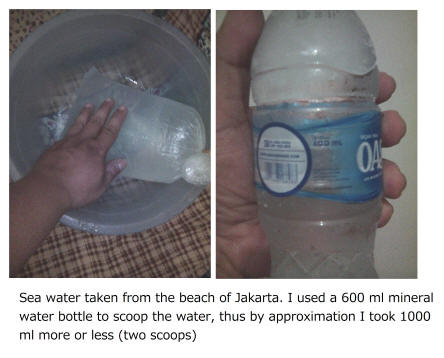
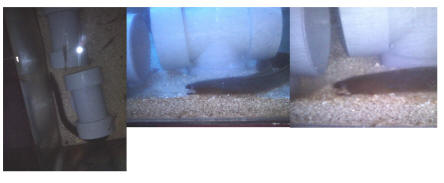 |
Re: Echidna rhodochilus, finally 11/3/17
Hello Neale,
<Ben,>
Thank you for your advice about the PVC pipe. Tonight I took out Echidna's cave
and replaced the PVC pipe back in. I noticed that the cave has rough edges and I
am afraid Echidna will scrape and hurt itself on those edges.
<Can certainly be a risk, but these eels do inhabit oyster reefs and mangroves,
so probably have some common sense here. Nonetheless, "safety first" is a good
maxim!>
Here is a clip of my lovely Echidna before I took out its cave. I hope it will
forgive me. My friend told me that Echidna Rhodhocilus are not as easily
stressed as other morays, is that true?
<Probably; they are physiologically adaptable, that is sure. Morays are hardy
anyway, and among the tougher marine fish, so a euryhaline one is likely to be
remarkably durable. The flip side though is that they've been
abused a bit over the years, kept in freshwater systems for too long, and surely
some have died prematurely because of that. We don't really know that much about
their diet and reproduction either, so might be missing
important things in those directions.>
https://www.youtube.com/watch?v=McgRWm92xN8
<Nice!>
I am fascinated with your info that it is us, Freshwater Moray keepers, who are
leading the (informal) research on FW moray behavior. I want to share this video
clip with you, sent to me by my friend who keep several Polyuranodons.... in
"FRESHWATER" for years ("Freshwater" because I he said he just fill his aquarium
with the water from the river where he caught the eels, but I never ran a
salinity check on those waters).....and after
years, he was able to train his Polyuranodons to eat BLOODWORMS... Isn't it
amazing? Here is the clip:
https://www.youtube.com/watch?v=816Z5mD9NDs
<Likely a major source of nutrition in the wild. Mosquito larvae are very common
-- and very important -- parts of the freshwater food chain. They are also
common in brackish water habitats too.>
Now you can put it on your notes, that there is a prove case from Indonesia, of
Polyuranodons actually kept in "freshwater" for years and trained to eat
bloodworms!
<Your messages are shared with everyone who reads WWM, whether now or in the
future!>
Off course, we have to take into account that this is Indonesia, the natural
habitat of these eels, and they are being kept in the water from their own
rivers, and the surrounding temperature is pretty much the same
(they are literally being kept in a city of the same island where they were
taken from). Therefore this should not be interpreted that I am advising fish
lovers in other countries (especially Western!) to start keeping Polyuranodon on
freshwater and feed them bloodworms, I don't! Because what works here in
Indonesia might not work in other places.
<Quite so. Your specimens have endured less handling and shipping -- it can
easily be months between capture and ending up in an American or European
aquarist's fish tank. That will make a difference.>
Well, thank you for your continuing attention and support!
Best Regards,
Ben
<Always glad to talk. Cheers, Neale.>
Re: Echidna rhodochilus, finally
11/6/17
Hello Neale,
Again, many thanks for your input & continuing support! WetWebMedia is really
blessing for all of us fish-lovers everywhere!
<Thanks for the kind words.>
Now I am inspired to train my Echidna to eat bloodworm too. Will post here the
results, though I am sure it will take a while. Maybe I will get another Echidna
as well, because what's better than one Echidna Rhodochilus? TWO Echidna
Rhodochilus! :D
<If they get along, at least...>
I will also try to acquire a G. Polyuranodon for the same purpose. Maybe when I
get two Echidnas, I will trade one for a G. Polyuranodon :D
I have thoughts on obtaining a G. Tile, however this species grows big, and I
don't have that much space in my current house for another aquarium.
Plus, though it is a known species in this part of Indonesia where I live, G.
tile and E. Rhodochilus are harder to find than G. Polyuranodon or even E.
Nebulosa.
<Really?>
Getting an FW moray around here is a bit tricky, because these days most of our
local fish catchers who supply ornamental fishes for fish shops, does not really
understand the taxonomy of the fishes. They use "catch-all"
terms for the fishes, for example, any eel types they caught in the estuarium,
they will say "It's a Belut Muara" (estuarian eel), whether it's Gymnothorax
Tile or Gymnothorax Undulatus or Echidna Nebulosa or even Gymnothorax javanicus.
I have to inspect what they caught, and sort the fishes by myself.
<Interestingly, when I Google the "Belut Muara" name I end up with mostly
Synbranchus-type swamp eels, such as Macrotrema caligans. These are
brackish-tolerant freshwater fish, more of low-end systems than mid-to-high
salinity systems. Synbranchus eels tend to be extremely aggressive and
predatory, so approach with care.>
It's much more effective to buy the fishes from hobbyists who hand-caught their
stocks, and know enough taxonomy to identify what they have caught... but then,
these hobbyists often developed emotional attachments to their pets & won't sell
their favorite ones.
<Indeed.>
Well, this has been a wonderful discussion, I hope it will be useful for
WetWebMedia readers & all "FW" moray lovers everywhere.
Thank you & Best Regards,
Ben
<And you; cheers! Neale.>
|
Re: Echidna rhodochilus, finally 11/15/17
Hello Neale and all you good people in WetWebMedia,
<Hello Ben,>
As I promised, here is the latest update of my Echidna Rhodochilus.
1. After I raised the salinity by pouring in seawater gradually, I noticed that
sand sticks on echidna's slime coat. I thought it was some kind of disease, but
when i gently touched the echidna, the sand came off. So I stopped raising the
salinity, at the weekly water change I no longer add seawater & did the water
change using freshwater from my well. Just a few days after, echidna went back
to normal with no more sticking sands.
<Quite normal behaviour. Mucous production is one way that scale-less fishes
like eels adapt to their environment. It's perfectly normal for them to produce
extra mucous at times, and eels of all kinds are famous for
doing this. It may well be that salinity changes trigger mucous production,
perhaps because it slows down water loss in more saline water.>
2. Echidna Rhodochilus are amongst the smallest of the moray, but they are
actually strong enough to rearrange their aquarium. My echidna is able to uproot
my bogwood ornament and moving its home pipes around as it sees fit. It is more
active now than weeks ago when I first got it.
<Again, eels are noted for their strength. Despite their sluggish behaviour
during the day time, they are actually effective and powerful predators at
night.>
3. It is very docile though, it never made any attempt to bite me whenever I
stick my hands inside the aquarium to put the pipes and bogwood back in place.
<On the whole Morays are known to be curious rather than aggressive towards
people, even wild Morays in the oceans.>
4. Maybe later, I'll temporarily (not long-term, maybe just days) put docile pet
fish from my other aquarium to test their compatibility with Echidna in a
semi/low-end brackish condition. I have a Monopterus albus which are larger than
the Echidna, and whose docility are guaranteed, it has been housed for years
with two Polypterus palmas, three clown loaches and two yo-yo loaches, and it
never caused trouble. Seems like a perfect candidate for the experiment. Or
maybe I put the clown loaches, as they have grown rather big and I am sure
echidna won't see them as food.
<Does sound like a good candidate for this, but I will caution you that
Synbranchids are often reported to bite companion fish, so keep a close eye on
things.>
And thank you for the tips in selecting caught fish. We never know what got
caught by local fish catcher here. Besides aggressive eels. sometimes even
marine food-fish like ikan layur/ribbon fish (Trichiurus lepturus) end up
in estuarium and get caught. Those fishes has nasty teeth!
<What a cool beast! One of the neatest fish I've seen in aquarium shops in
England is another eel, Congresox talabonoides, sometimes called the Pike Conger
Eel. It's a brackish to marine fish, and seems quite hardy and
peaceful. But it is predatory, and apparently sometimes reaches over 200 cm in
length!>
Best Regards,
Ben
<Thanks for the photos. Cheers, Neale.>
|
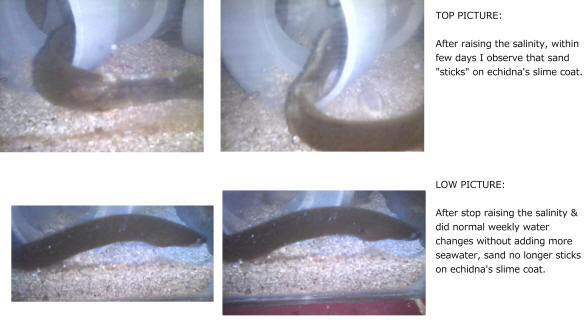
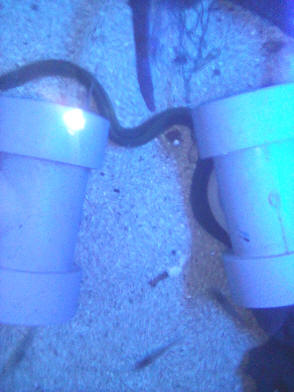 |
|
small error 9/5/17
60 cm is 24 INCHES, not 24 FEET.
<Hee!>
Species
The by far most common moray eel sold as a freshwater fish is
Gymnothorax tile, it is often simply referred to as 'freshwater moray
eel'. Sometimes it is labeled 'Indian mud moray', 'snowflake eel' (not
to be confused with the other 'snowflake eel' Echidna nebulosa) or 'gold
dust moray'. It is grey and has numerous yellow to golden spots spread
on the dorsal and lateral part of the body. With age the yellow spots
become smaller giving the adults a more or less uniform grey appearance.
They are common in the Sundaban mangrove swamps in East India, but they
are also distributed in Indonesia, the Philippines and the Andaman
Islands. The species reaches a maximum length of 60 cm (24').
<Can you tell me the URL where you found this error? Thank you, Bob
Fenner>
Ahh, I found it:
http://www.wetwebmedia.com/fwsubwebindex/fwmorayart.htm
Thanks again. BobF
|
|

